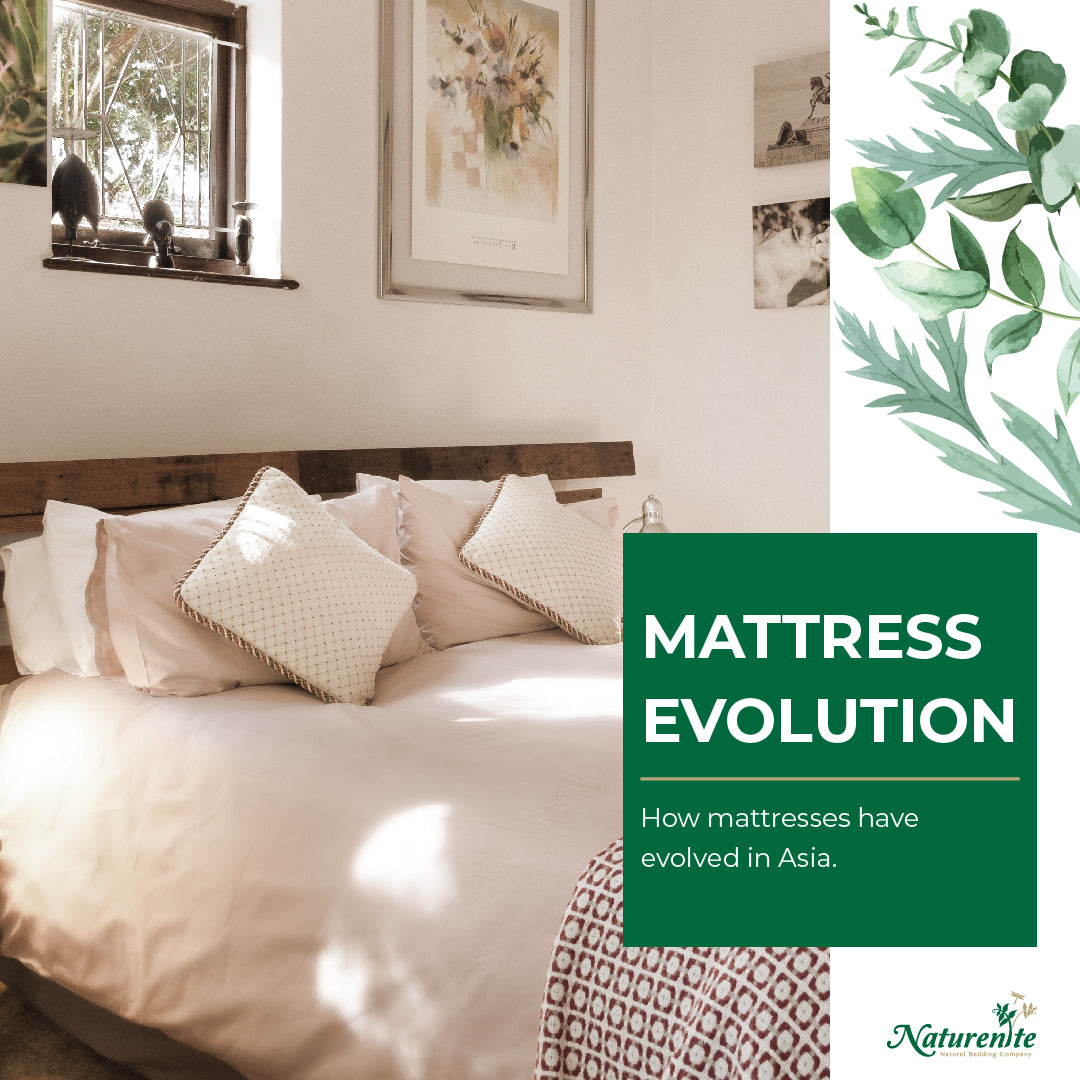
‘We used to sleep on tikar you know!’
Haven’t we all heard of this famous line when our parents (or grandparents) speak of how the whole family slept together in their living room? Humanity has come a long way in our sleep mannerisms. If you’ve subscribed to our blogs, you’re probably a prime example of peak human evolution that’s looking to improve sleep experience. How did we start? And where do we stand now? Read further to understand the history of mattresses in Asian civilization.
Natural beds
The oldest mattress was discovered at Sibudu Cave site in KwaZuzu-Natalin around 70,000 years ago. It was uncovered that our ancestors made mattresses with leaves that contained insect repellent properties to get rid of insects. On top of that, most beds were also noted to have been burnt to kill pests before moving to the next site. These large beds stretched up to 22 square footbeds to accommodate the tribes that moved together thus indicating that sleep was also an activity done in a communal manner. Sleep in the early days prioritized safety from natural elements. It was at this time mankind started migrating to Asia.
Tatami
Tatamis first gained popularity back in the 16th century in Japan and was only accessible to the nobilities of Japan as a seating option. Tatami is derived from the word tatamu (to fold) indicating that these beds were designed in a way that it’s easily piled or folded. The bed version of Tatamis is known as goza and was used only by nobility and samurais to sleep on while commoners slept on mats. Tatami beds were made of straws of herbaceous flowering plants known as the soft rush. The firm underfoot yet soft cushion also releases a sweet scent especially during rainy and humid days and is said to bring great wellness to the body. To date, the tatamis are commonly found in Japanese households but barely for sleeping purposes. It is more commonly used now as floor paddings.
Kang
Around the 18th century, mud beds or ‘Kang’ were found in most Chinese households and used by commoners. As home activities were done on the floor, naturally their beds too, were built on floors. Kang were multipurpose structures that were used as floor, table, chairs and heater. Kang too, apparently emitted heat that kept homeowners warm.
Ancient Chinese Bed
In Ancient Chinese history, beds played a more cultural significance rather than providing a better sleeping experience. Bed Frames were carved with cultural symbolism in wood to add luxurious elements in one’s room.
Luohan Bed
Fixed with three solid board railings, the Luohan bed is influenced by the Ming Dynasty’s cultural style. Depending on the size of the bed itself, the purpose varied. It was either used as a sofa to decorate living room spaces, or a bed for relaxation purposes. It was uncommon to find these beds in a bedroom, but it was frequently used for sleep, nevertheless.
Babu Bed
Also an origin of the early Chinese civilization, the Babu bed was a bulky and heavy bed frame influenced by Taoism symbolism. This was due to its popularity that raised during the reign of Jiajing Emperor of the Ming Dynasty who was a firm believer in Taoism. These beds too didn’t place much importance on the mattress but was known for their intricate woodwork of the bed frames that always had the word 寿”(Longevity) and “福”(Happiness) carved on it.
Straw Mat
Around the same period, straw mats were also used as beds. Some houses used mats on top of Kang as padding. In Southeast Asian countries, only straw mats were used as the temperature in this region was generally warmer and did not require heat. Made out of dried palm leaves, straw leaves had lower durability and so straw beds were eventually made out of bamboo to extend its durability. To date, many households still own straw mats as surface decoration. As you may have realized by now, straw mats were a common choice of bedding option especially for commoners in all regions.
Charpai
An Indian originated bedding structure, many households in Southeast Asia also used charpai as beds. The frame is made out of natural fiber that withstood weight. It was one of the first high-risen beds found in Asian households. Eventually, these forms of beds were made out of wood for longer durability, but we doubt it provided any comfort!

Daybed
Overtime, daybeds gained popularity. Daybeds were also used as seating in lounge areas. It was at this period mattresses were commonly used as daybeds came with link springs, to act as a support for mattresses. These forms of beds were made out of wood or metal or sometimes both. Mattresses used around this period, on the other hand, were usually made out of cotton.
Coil Spring Mattresses
In the late 19th century, coil spring mattresses became more available and preferred in the Southeast Asian region. Metal frames too, became more common. At the beginning of the 20th century, beds and mattresses were mass-produced for the first time, making them more accessible. King Koil was one of the first providers in Malaysia that eventually grew into mattress suppliers for luxury hotels with their coil spring mattresses.
Latex Mattresses
Obtained from rubber trees, latex mattresses soon sparked in popularity especially here in Malaysia. Due to our climate and soil, harvesting rubber trees were fruitful. Malaysia has been a top exporter for latexes, and naturally we began to mass-produce latex beddings. It is said that the first household to have owned latex mattresses were the British royalty and thus began its popularity in the market. This was all before latexes were toppled off by polyurethane foam.
Polyurethane Foam Mattress aka Memory Foam Mattress
A hike in popularity was observed with memory foam mattresses in Malaysia. More mattress producers were keen due to the ease of production and its’ lower production cost. In the earlier stages of memory foam mattress production, mattresses were made at with lower density hence the presenting lightness of the mattress itself. However, the low-density level of the mattress meant that a shorter lifespan as compressions take place after frequent use. A peak in mattress sales were observed as returning customers walked into stores to replace their mattresses more frequently than ever.
Wrapping Up
The history of mattresses in Asia was commonly crafted around the culture and society of countries in Asia. It was also impacted by the resources available as it dictated the material of these mattresses. Due to trading and globalization, more comfortable mattresses became available and people were no longer limited with their mattress choices. Today, one can simply place an order for a mattress on their phone and buy ones they deem fits their lifestyle. It’s amazing how far the civilization of mattresses have stretched!




